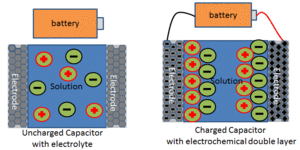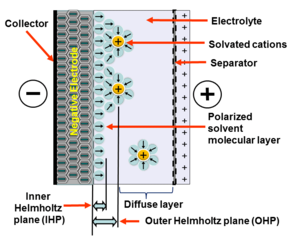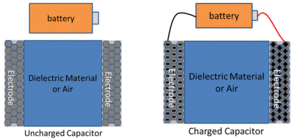Double-layer capacitance facts for kids
Double-layer capacitance is a way to store electrical energy. It uses something called the electrical double layer effect.
This happens when an electrode (a part that conducts electricity) touches a special liquid called an electrolyte. When electricity is applied to the electrode, its surface gets charged. This attracts tiny particles in the liquid that have the opposite charge. These particles stick to the electrode, forming a first layer. Then, another layer of oppositely charged particles forms on top of the first one, but they aren't stuck as tightly.
These two layers are separated by a super-thin space of neutral particles from the liquid. This "sandwich" of charges can store electrical energy. The amount of energy stored depends on how much electricity was first put into the electrode. Once this energy is stored, you can unplug the power source, and the device can still power things until the energy runs out.

The amount of electric charge stored in double-layer capacitance grows steadily with the amount of voltage applied. It mostly depends on the surface area of the electrode. The unit for measuring capacitance is the farad.
Contents
What is a Capacitor?
A capacitor is a common electrical device that stores electrical energy as charge. Think of it like a tiny battery that can store and release energy very quickly.
Most capacitors work by having two metal plates separated by a gap. When you put electricity into them, one plate gets a positive charge and the other gets a negative charge. The gap between them can be filled with a special material called a dielectric. This material helps prevent the electricity from jumping across the gap, allowing more charge to be stored. Air can also act as a dielectric if nothing else is there.
How Liquids Help Store More Energy
Instead of using a solid dielectric material, some capacitors use a liquid solution. This allows them to store even more energy!
When these capacitors charge, positively charged particles in the liquid are attracted to the negatively charged electrode. The same thing happens with negatively charged particles and the positively charged electrode. These particles stick to the electrode's surface. Then, they pull in other oppositely charged particles from the liquid, forming a kind of "sphere" around them. However, these outer particles aren't attached as strongly.
These two layers in the liquid help prevent similar charges from pushing each other away too much. This allows the device to store a lot more charge. Scientists noticed that the voltage drops across this special layer, just like it does in a regular capacitor. This led to the term "electrical double layer" in the 1850s, which later became "electrical double layer capacitance" (EDLC). Since this double layer forms at both electrodes, the device can theoretically store a lot more energy.
Cool Uses for Double Layer Capacitors
When the idea of double layer capacitance is used to make a device, they are often called "ultracapacitors." They store energy by separating charges, similar to a regular capacitor, but they can hold much more energy. They don't use chemical reactions to store electricity, like traditional batteries do.
This means ultracapacitors can work correctly for a much longer time. Also, charging them takes less time than charging a traditional battery. However, the liquid inside them can dry up over time, which eventually causes the device to stop working.
Today, ultracapacitors are used in many devices, including:
- Wireless modems
- GPS devices
- CMOS computer chips
- Solar-powered devices
- Windmills
- Electric cars
- Power tools
Electric double layer capacitors (EDLCs) can power a device for longer than a traditional capacitor. However, they can't give out as much instant energy as a traditional capacitor, which can release all its energy at once. Rechargeable batteries can power a device for longer than an EDLC per charge, but they also can't deliver as much instant energy.
Images for kids




